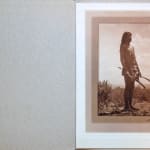

Edward S. Curtis American, 1868-1952
Provenance
I am the second owner of this print. The original Seattle collector having purchased this print directly from the Curtis Studio, Seattle.
Edward S. Curtis, unlike most photographers of his era, actually created a larger body of Platinum Prints than of Silver Prints. While Platinum Prints comprise well under one half of one percent of the extant Curtis work, the Curtis Silver Print exists in even fewer numbers by a significant factor. Given that Silver prints by Edward Curtis are rare to begin with, this example is considered extremely rare even by the standards for a Curtis Silver Print given that it remains intact in its original Presentation Folio. The majority of vintage silver gelatin Double Border prints by Curtis were long ago separated from their original presentation mounts and are found loose.
The Silver prints were made on a paper sensitized with an emulsion silver salts; usually silver bromide, iodide, or chloride. After developing, they were carefully toned to bring out and enhance the subtle tones of Curtis’ prints and to make those prints more permanent. Frequently, they were double printed to give a border effect.
The Snake Dance is the best known of all the Hopi ceremonies, and lasts 16 days. It is a dramatized prayer for rain and is performed in late summer. Snake Priests are traditionally servants of a snake chief. Among their various duties the snake priests collected snakes for the ceremony and also danced in the ceremony while holding rattlesnakes in their hands, around their necks, or even between their lips.
Curtis was the first white person inducted into the Snake Priesthood, which not only was a great honor but also a testament to the deep trust and acceptance accorded him by the Hopi People. Curtis visited the Hopi numerous times over a twenty-five year period. His photographs and text relating to the Hopi Snake Dance are an anthropological tour de force. This Curtis image of the Hopi Snake Priest was not published in The North American Indian.

